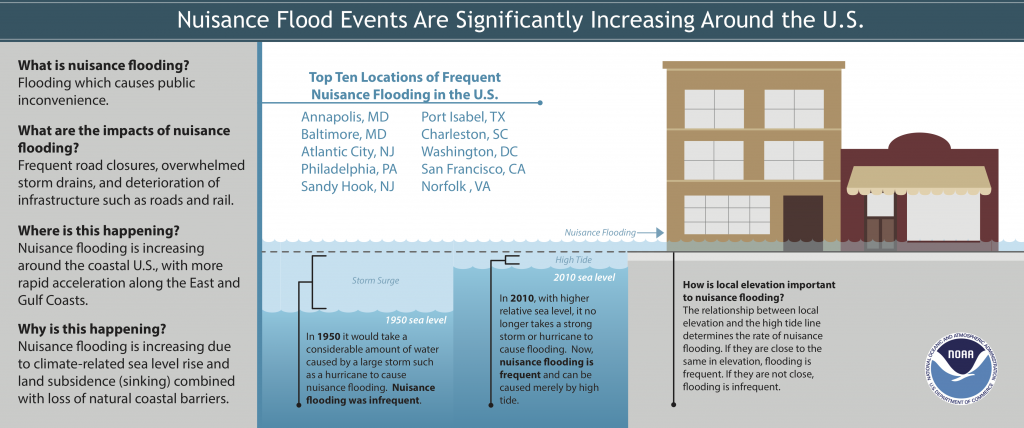The Growing Threat Of Rising Sea Levels: Impacts And Mitigation Strategies

Table of Contents
The Impacts of Rising Sea Levels
The effects of rising sea levels are multifaceted and devastating, impacting both the natural world and human society. Understanding these impacts is crucial for developing effective responses.
Coastal Erosion and Flooding
Rising sea levels significantly exacerbate coastal erosion. Higher water levels increase the power of waves and storm surges, leading to the accelerated loss of beaches, cliffs, and other coastal features. This erosion undermines infrastructure, leading to property damage and loss. Simultaneously, the increased frequency and intensity of coastal flooding events threaten lives, livelihoods, and coastal economies. Low-lying areas and island nations are particularly vulnerable.
Examples of regions acutely vulnerable to coastal erosion and flooding include the low-lying islands of the Pacific and Indian Oceans, the coastal areas of Bangladesh, and many parts of the US East Coast.
- Increased damage to infrastructure: Roads, buildings, and utilities are susceptible to damage and destruction.
- Displacement of populations: Coastal communities face displacement and relocation due to inundation and erosion.
- Saltwater intrusion into freshwater sources: Rising sea levels contaminate freshwater aquifers and agricultural lands with saltwater, impacting drinking water supplies and food production.
- Loss of coastal ecosystems: Essential habitats like mangroves, salt marshes, and seagrass beds are lost, impacting biodiversity and coastal protection.
Threats to Ecosystems and Biodiversity
Coastal ecosystems, vital for biodiversity and crucial to protecting coastlines, are severely threatened by rising sea levels. Mangrove forests, salt marshes, and coral reefs act as natural barriers against storms and erosion, but rising waters inundate these habitats, destroying them.
The impact on marine life is equally dire. Coral reefs, often called the "rainforests of the sea," are particularly vulnerable to rising sea temperatures and ocean acidification, both exacerbated by climate change. This leads to coral bleaching and the loss of crucial habitat for countless marine species. Many species face habitat loss and potential extinction.
- Coral bleaching: Rising ocean temperatures cause coral to expel the algae living in their tissues, leading to bleaching and death.
- Habitat loss for migratory birds: Coastal wetlands, vital for bird breeding and migration, are inundated.
- Disruption of food chains: Loss of key species and habitats disrupts the delicate balance of marine ecosystems.
- Changes in ocean salinity: Sea level rise alters salinity levels in coastal waters, affecting the survival of many species.
Economic and Social Consequences
The economic costs associated with rising sea levels are staggering. Damage to infrastructure, the need for relocation efforts, and the loss of tourism revenue represent billions of dollars in losses annually. This economic burden disproportionately affects developing nations, which often lack the resources to adapt effectively.
Socially, rising sea levels lead to displacement, migration, and potential conflicts over dwindling resources. Vulnerable populations, including low-income communities and indigenous groups, often bear the brunt of these impacts.
- Increased insurance costs: Higher risks lead to increased insurance premiums for coastal properties.
- Loss of livelihoods: Fisheries, tourism, and agriculture are significantly impacted, leading to job losses.
- Social unrest: Displacement and resource scarcity can lead to social tensions and conflicts.
- Health impacts from contaminated water: Saltwater intrusion contaminates freshwater sources, increasing the risk of waterborne diseases.
Mitigation Strategies for Rising Sea Levels
Addressing the threat of rising sea levels requires a multi-pronged approach encompassing both mitigation and adaptation strategies.
Reducing Greenhouse Gas Emissions
The most effective long-term solution to rising sea levels is to drastically reduce greenhouse gas emissions. This requires a global commitment to transitioning to cleaner energy sources and implementing sustainable practices across all sectors. International agreements like the Paris Agreement are crucial, but national-level policies and individual actions are equally important.
- Carbon capture technologies: Developing and deploying technologies to capture and store carbon dioxide emissions from power plants and industrial sources.
- Investment in renewable energy: Shifting from fossil fuels to renewable sources like solar, wind, and hydropower.
- Improving energy efficiency: Reducing energy consumption through better building design, more efficient appliances, and sustainable transportation.
- Sustainable transportation: Promoting public transport, cycling, and walking, as well as investing in electric vehicles.
Coastal Protection and Adaptation Measures
While reducing emissions is crucial, adaptation measures are also necessary to protect existing coastal communities and infrastructure. These strategies can include:
- Seawalls and levees: Building physical barriers to protect against flooding and erosion.
- Beach nourishment: Replenishing beaches with sand to protect against erosion.
- Wetland restoration: Restoring and protecting coastal wetlands to act as natural buffers against storms.
- Early warning systems: Developing systems to alert communities to impending flooding events.
- Improved building codes: Enforcing stricter building codes to ensure that coastal structures can withstand flooding and erosion.
International Cooperation and Policy
Addressing rising sea levels demands strong international cooperation. Sharing best practices, coordinating mitigation efforts, and providing financial and technical assistance to vulnerable nations are essential.
- Sharing best practices: Countries can learn from each other’s successes and failures in adapting to rising sea levels.
- Funding research and development: Investing in research to develop new technologies and strategies for mitigating and adapting to sea level rise.
- Supporting vulnerable nations: Providing financial and technical assistance to developing countries to help them adapt to rising sea levels.
- Promoting sustainable development goals: Integrating sea level rise mitigation and adaptation into broader sustainable development strategies.
Conclusion
The impacts of rising sea levels are profound and far-reaching, threatening coastal communities, ecosystems, and the global economy. The urgency of the situation cannot be overstated. We must act decisively to implement both mitigation and adaptation strategies. Reducing greenhouse gas emissions is paramount, and we must concurrently invest in coastal protection and adaptation measures. International cooperation is crucial to sharing knowledge, resources, and responsibility.
Learn more about rising sea levels and their effects. Support policies that promote renewable energy and sustainable coastal management. Advocate for responsible environmental stewardship and reduce your carbon footprint. Support organizations working to combat the effects of rising sea levels. Together, we have a collective responsibility to address this global challenge and protect our planet's vulnerable coastlines for future generations. The future of our coasts depends on our immediate and collective action against rising sea levels.

Featured Posts
-
 Asylum Shelter Efficiency Advisory Councils Call For E1 Billion In Savings
May 11, 2025
Asylum Shelter Efficiency Advisory Councils Call For E1 Billion In Savings
May 11, 2025 -
 Bayern Munichs Mueller Departure Fan Reactions And Future Implications
May 11, 2025
Bayern Munichs Mueller Departure Fan Reactions And Future Implications
May 11, 2025 -
 The 500 Most Powerful Individuals In Washington Dc For 2025
May 11, 2025
The 500 Most Powerful Individuals In Washington Dc For 2025
May 11, 2025 -
 The Chaplin Factor A Key To Ipswich Towns Success
May 11, 2025
The Chaplin Factor A Key To Ipswich Towns Success
May 11, 2025 -
 Michael Johnsons Grand Slam Track Meet A Promise Of Thrills
May 11, 2025
Michael Johnsons Grand Slam Track Meet A Promise Of Thrills
May 11, 2025
